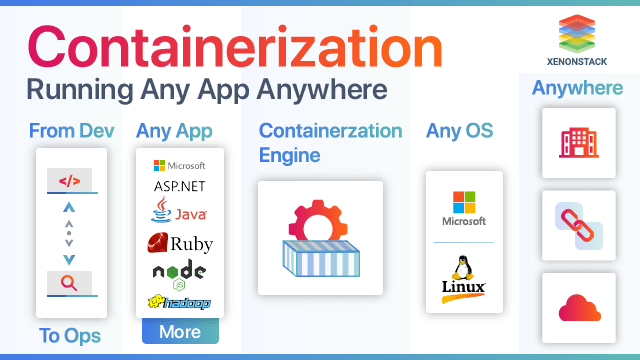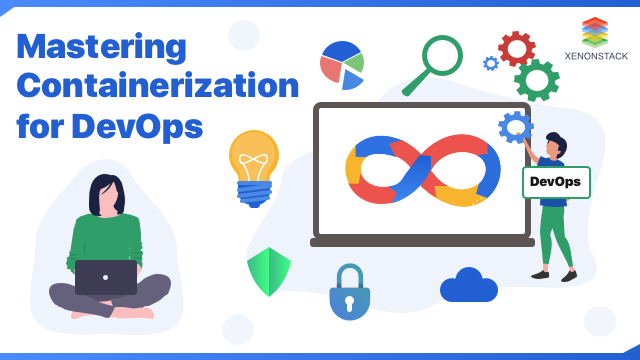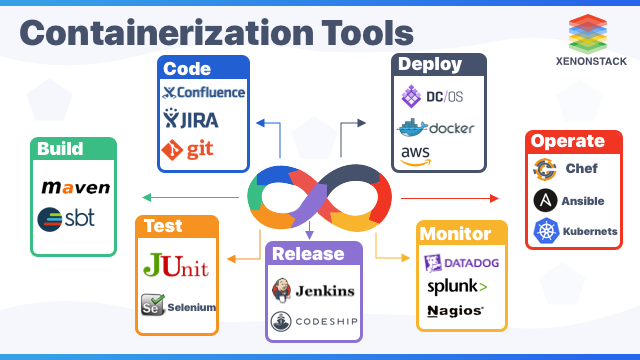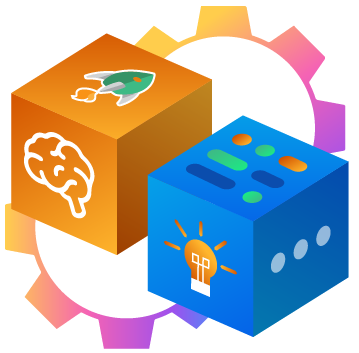
Introducing Containerization
Before we go ahead with Containerization, first, let us know what 'Containers' are. Containers are the standard unit where an application is consolidated into a package with its dependencies, resources, libraries, source code, and many more. This helps to attain portability and reduction in size. The process of making an image into a consolidated package (container) is known as Containerization. Containers help the developers help their applications run in any environment and not get dependent upon the host's hardware. Containers have a motive to build once and run everywhere. It is like managing multiple applications and their dependencies and libraries with OS-level virtualization so that applications could be deployed elsewhere without the need for any OS overhead. It follows this same process throughout, whether there is application containerization or something else related to it.Containerization in DevOps
It is packaging an application. But when you talk about the case of DevOps, it is the practice of bringing together all the departments of the IT sector and build some productivity. But the thing with DevOps processes is that it is not fixed for a particular technology. There could be a chance that you would hold a different technology than containers. Yes, when they both collaborate, the benefits are somewhat everyone wants to attain so that the end product of the application would be an efficient one. The collaboration of DevOps with containers provides many advantages to the lifecycle of software development. When you work with DevOps, you would have the upper hand while working with it as you can change between multiple frameworks on the fly, and the container's implementation gets associated with it. The end product of software development is very efficient. The updates and the deployments are often in the software, so we need a reliable source to handle these persistent updates. Know more about Containers in DevOps here.
Infrastructure as Code is provisioning & managing infrastructure like ECS, AKS, VPC, etc. Click to explore about our, Infrastructure as Code and Containers
What are the advantages of Containerization?
Highlighted below are 4 major advantages of containerization in IT.
Portability
The main advantage of a container is its independent nature, which differs from virtual machines. The idea behind it is to provide the whole environment without even getting dependent upon the host hardware, limiting the problem of specification, and covering efficient resource usage.
Light Weight
Not being dependent upon the hardware means it is not having any overhead or OS associated with it. This container property helps you transfer your application from one environment to another without any overhead problem.
Speed
The speed associated with containers gives out the solution to many problems. For example, if you have deployed an application through containers, then usage and the functionality associated with the application would be way much more efficient than that same application used through Virtual Machines.
Cost-Efficient
The cost-efficiency of containers is very much the sole reason companies adopt this technology and make their applications more containerized. The lower price soothing the same efficiency as that of well built and architect application whose building value is more than that of a container.

What are the disadvantages of Containerization?
Everything in this world has its own pros and cons. Highlighted below are two major drawbacks of using Containerization.Security
One can not ignore the security issues with the container and associated containers. In reality, hackers can penetrate its OS-level virtualization. Yes, they do have this flaw, but it is not that easy to breach containers' security. While in the case of Virtual Machines, you have a hypervisor that provides a petite point of the breach, which is more secure than that of the container's surfacer.Monitoring
Sometimes, there could be a chance that many containers are working on the same server, which is a good thing. But when you look at the maintenance side, you will find it very hard to manage it all. This could lead to many mishaps around the system.This process is something that does not save or reference information about previous operations. Click to explore about our, Stateful and Stateless Applications
What are the best Containerization tools?
Many tools work their best to provide efficient containerization. If you search for it out in the market, you will find many tools and companies with their tools or some research in containers' essence. Let’s put on some of these tools currently very famous and make their presence in the market.
Let’s put on some of these tools currently very famous and make their presence in the market.
Docker
The sole purpose of the docker is to provide the containerization to the application and manage it. First, the image is issued with all its dependencies written in a file, and then that file is converted into the container from that. Once done with creating the container, you can push your content onto the repository, i.e., DockerHub, where you could easily pull and push your application or say your container from anywhere. Know more about Docker Container here.Kubernetes
Kubernetes is a useful container orchestration platform that helps in deploying, managing, and scaling containerized applications. In kubernetes, the containers reside inside pods, which are the smallest unit that exists in kubernetes. It contains containers inside it. Commonly, only one container resides inside a particular pod, but two containers could also be inside a pod if needed. Clear your doubts on Kubernetes Deployment and become a master in the same with us here.AWS
With its service named ECS, Elastic Container Service, AWS is also in the run for the best tool that could be used to manage and maintain the containers using other cloud amenities. Like ECS, we have EKS (Elastic Kubernetes Service), which deals with Kubernetes on AWS. Interested to learn more about AWS Serverless Computing? Click here.
Conclusion
Various containerization tools are available in the market that could best suit our requirements. The power of containers helps them get the desired output, irrespective of the OS at the client-side or other dependencies. In the lifecycle of software, there could be multiple rolling updates necessary for creating the best software. Now, you get to choose which containers are the best fit and capable of updating very easily and quickly on the go for you.
- Discover more about Data Warehouse Database Design Architecture
- Click to read about Minio Distributed Object Storage
.webp?width=1921&height=622&name=usecase-banner%20(1).webp)


